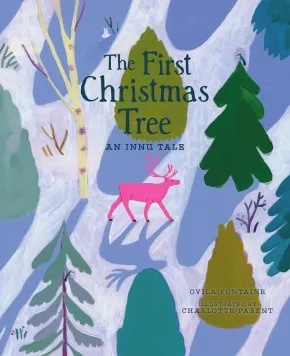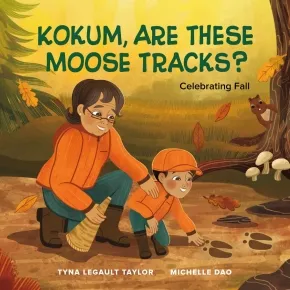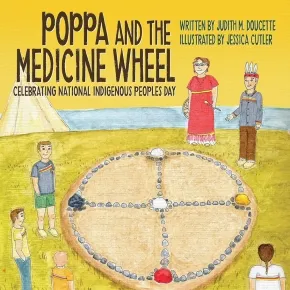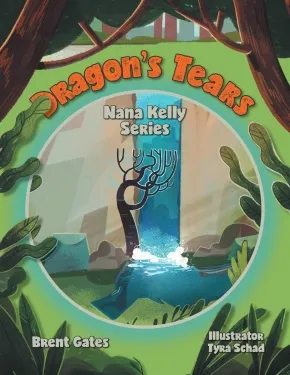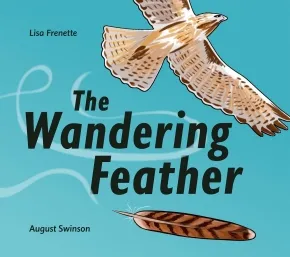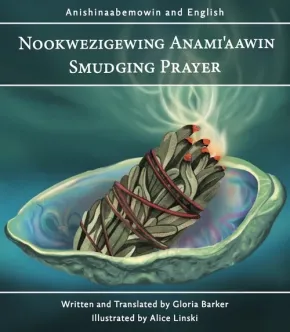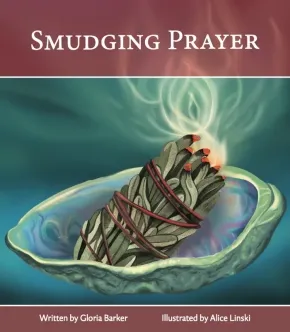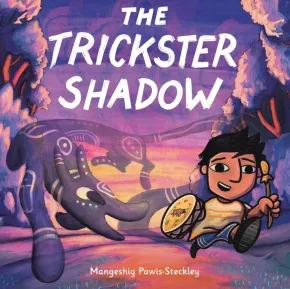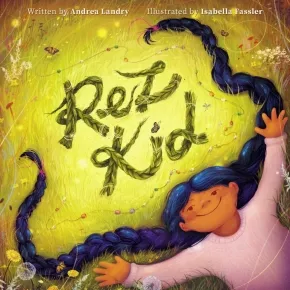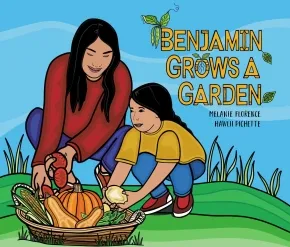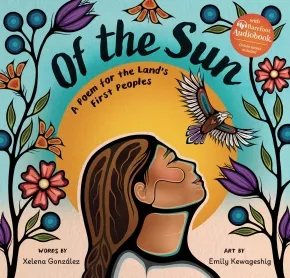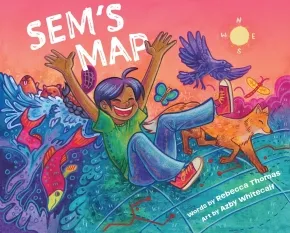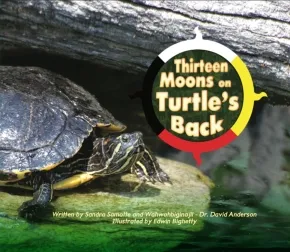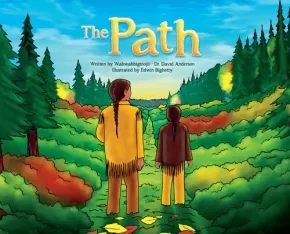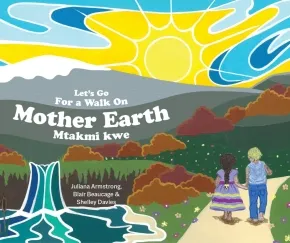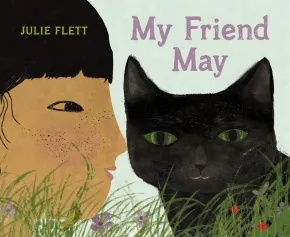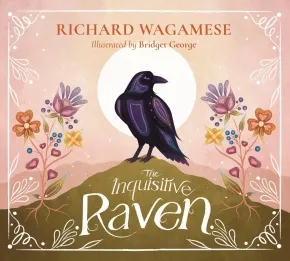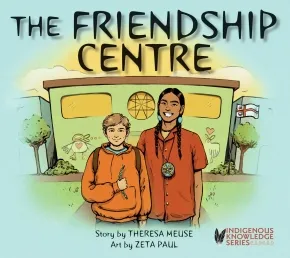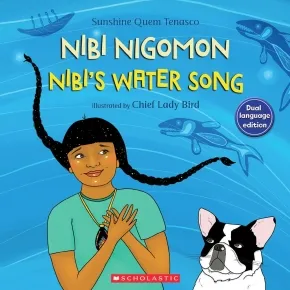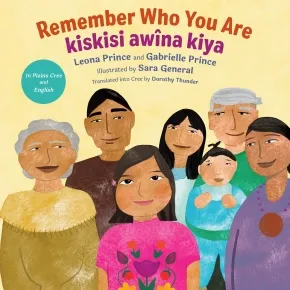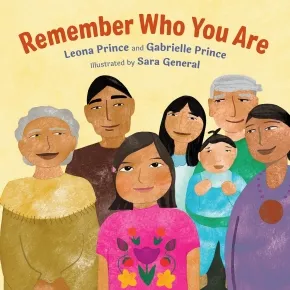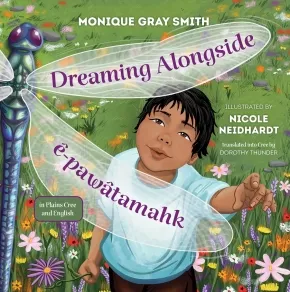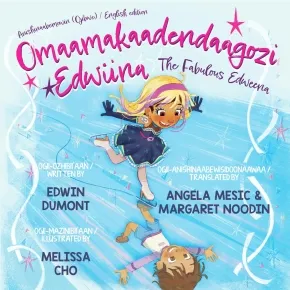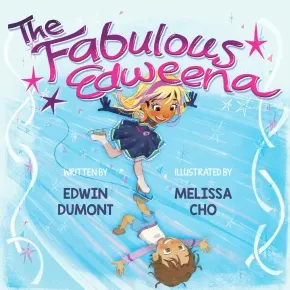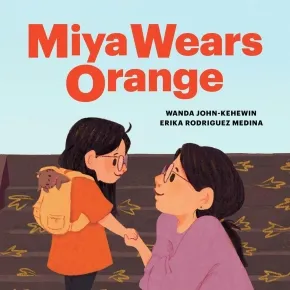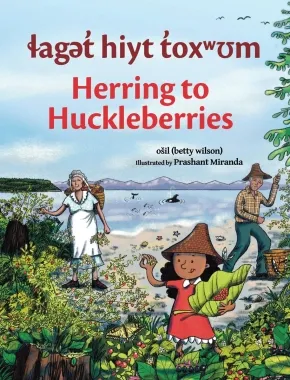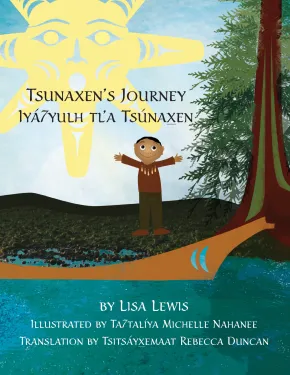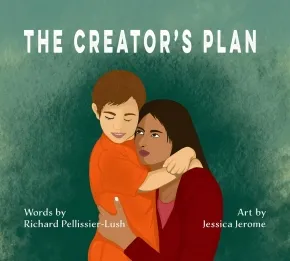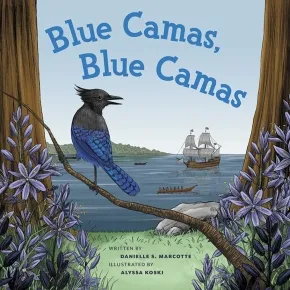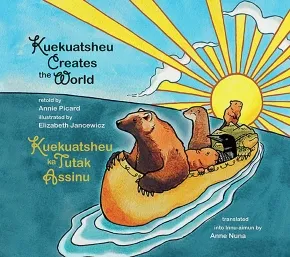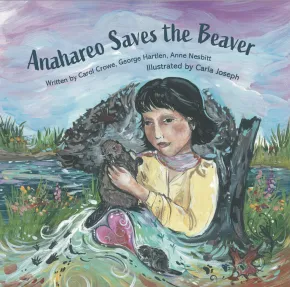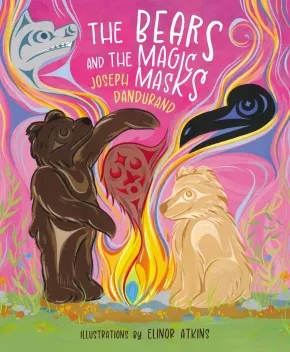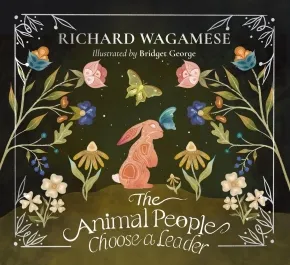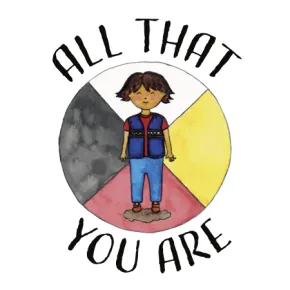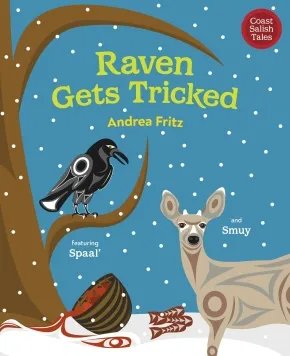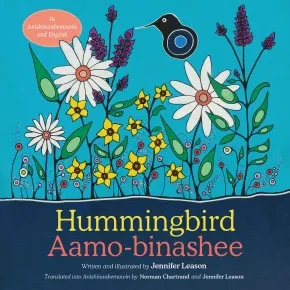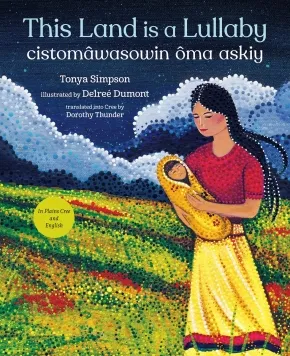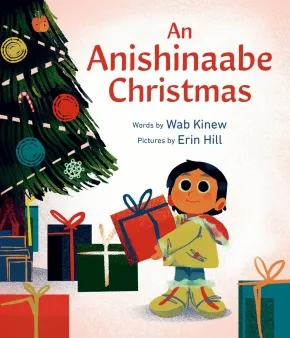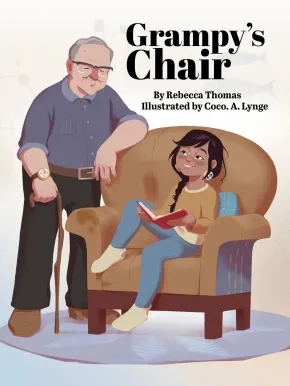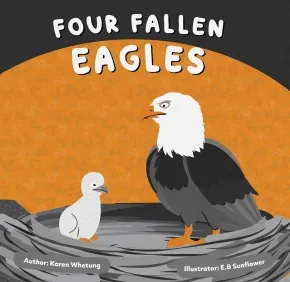
First Nations
1
-
15
of
324 Results;
Sort By
Go To
of 22
The First Christmas Tree: An Innu Tale
$24.95
Artists:
Format:
Hardcover
Text Content Territories:
Indigenous Canadian; First Nations; Innu (Montagnais-Naskapi);
Grade Levels: Preschool; Kindergarten;
ISBN / Barcode: 9781459841802
Synopsis:
Synopsis:
It is very cold in the Far North.
The Great Manitou knows that winter is the harshest season for the Innu, and he decides to find a way to make their winters a little brighter. He searches through the trees in the forest to find one who will bring joy, beauty and warmth to all. Could it be the larch, the tree that the Innu use to make sleds, bows or ointments? The birch, malleable and robust? Or the magnificent black spruce? “Do you want to become the Christmas tree?” he asks each one. But one after the other, the trees decline his offer. All except one, the little fir tree, whom the Great Manitou had initially overlooked.
Reviews
“The Great Manitou appears in vibrant fuchsia as various woodland creatures, standing out against the cool winter palette. A Christmas-themed look into Indigenous culture tradition that encourages further exploration.”— School Library Journal (SLJ)
Educator Information
Recommended for ages 3 to 5.
This book is available in French: Le premier arbre de Noël.
Additional Information
56 pages | 8.50" x 10.75" | Hardcover
Kokum, Are These Moose Tracks?: Celebrating Fall
$21.95
Artists:
Format:
Hardcover
Text Content Territories:
Indigenous Canadian; First Nations; Anishinaabeg; Ojibway; Cree (Nehiyawak); Swampy Cree ; Attawapiskat;
ISBN / Barcode: 9781774921470
Synopsis:
Synopsis:
Young readers will get ready for autumn on a moose tracking adventure with Joshua and Kokum.
When the harvest begins every fall, Joshua looks forward to eating Kokum's delicious moose meat stew at family feasts. He loves being on the land, and he can't wait to go moose hunting with his kokum.
Joshua and Kokum are careful not to make too much noise as they look for moose tracks in the forest. There are so many different animal tracks and Joshua can find them all. But which ones are moose tracks?
In the back of the book, find a glossary and pronunciation guide for the Omushkegomowin (Swampy Cree language) and Anishaabemowin (Ojibwe language) words featured throughout the story. A wonderful cultural learning experience for 5- to 8-year-olds!
Reviews
"A great learning tool for kids! This book not only teaches Omushkegomowin and Anishinaabemowin words and how to identify different animal tracks, but also, and most importantly, it instills respect for all living creatures and consideration for Mother Nature. I hope to one day harvest a moose with my kids, but in the meantime, we’ll try Kokum’s recipe for moose meat stew." — Chuck Hughes, chef and host of Chuck and the First Peoples' Kitchen
Educator & Series Information
Recommended for ages 5 to 8.
Reading Levels:
- Fountas & Pinnell Text Level Gradient: L
- Lexile measure: 760L
This book is part of the Joshua Learns from the Land series.
Additional Information
40 pages | 8.50" x 8.50" | Hardcover
Poppa and the Medicine Wheel
$18.95
Format:
Paperback
ISBN / Barcode: 9781774572535
Synopsis:
Synopsis:
June 21 is celebrated all over Turtle Island (North America) as National Indigenous People’s Day. François and his friends are excited to celebrate their first public commemoration of this day with Poppa. They will host a morning sunrise ceremony, including Poppa’s teaching on the Seven Lessons of the Mi’kmaw Medicine Wheel.
In this third book of the “Poppa” series, Poppa celebrates his first National Indigenous People’s Day with his Mi’kmaw Community of St. George’s, Newfoundland and Labrador. He can finally do so without fear of discrimination or oppression. After many years of having to hide his Indigenous ancestry, due to the colonial assimilation of his generation, Poppa’s grandson, François, invites him to his school as a respected Mi’kmaw Elder.
Poppa realizes with much joy that his Indigenous culture is bursting with revitalization and renewed pride in a heritage he feared would be lost and forgotten forever. He does not have to practise his cultural ceremonies in private any longer.
Come, join us as we rediscover the teachings of our Mi’kmaw Medicine Wheel and how our ancestors depended on it as a valuable teaching tool for our Peoples. The lessons of the Medicine Wheel are deeply profound and rich with Indigenous spirituality. The Medicine Wheel begs the utmost respect for the Creator as well as every other living creature in existence.
We are all connected in this great circle of life, and we are encouraged to share in each other’s life journey with the help of our Spirit Guides and ancestors’ guidance. Poppa invites us to participate in celebrating the joy of this day with him. Let’s all seek to find our own balance and reconciliation with love and acceptance that can be found within the realms of our own Mi’kmaw Medicine Wheel.
Educator & Series Information
Recommended for ages 5 to 12.
This book is part of the Poppa Series.
Additional Information
32 pages | 8.50" x 8.50" | Paperback
Dragon's Tears
$16.52
Artists:
Format:
Paperback
Text Content Territories:
Indigenous Canadian; First Nations; Salish; Coast Salish; Penelakut;
ISBN / Barcode: 9781038330376
Synopsis:
Synopsis:
At Elk Falls on Vancouver Island, the children gather around the campfire, ready for one of Nana Kelly’s stories.
She tells them of a time, long ago, when dragons were born from the love of forest creatures and the flames from the Great Spirit’s fire. As the wood burned low, that love and warmth filled the logs—and the Great Spirit transformed them into glowing dragon hearts and heads. Lifted by the fire, the heads floated toward the falls, where only the rushing water could give them bodies and give them life.
But when the ancient forests were cut down, only one dragon remained. Lonely and full of sorrow, it wept—until one night, the dragon’s tear met a glowing ember . . .
Momo, carrying her heart in her mouth, must find her way to the falls before her small body fades. With help from the Princess of Peace and a river full of salmon, Momo races against time to complete her transformation into a dragon.
A story as old as the forests and the falls, Dragon’s Tears shows how love, courage, and the kindness of others can bring something beautiful back to life.
Educator Information
Recommended for ages 11 and under.
Additional Information
28 pages | 8.50" x 11.00" | Paperback
The Wandering Feather
$22.95
Format:
Hardcover
Text Content Territories:
Indigenous Canadian;
ISBN / Barcode: 9781771476287
Synopsis:
Synopsis:
In this charming debut, a feather from a red-tailed hawk finds its home in a little girl's dreamcatcher
When a gust of wind blows a feather off a flying red-tailed hawk, it marks the beginning of that feather's quest to find a new home. The feather ends up in a squirrel's nest, a woman's hat, and atop a sandcastle-but none of these spots feel right.
Soon, the feather is picked up by a little girl who lovingly takes it home to join two other feathers as part of a special craft project. When the project is complete, the reader discovers that the feather has found its home in a dreamcatcher.
Bright illustrations bring young readers along on this lost feather's search for purpose, and the heartwarming conclusion weaves in a tribute to an Indigenous cultural object.
Educator Information
Recommended for ages 4 to 7.
Fountas & Pinnell Text Level Gradient: M
Lexile measure: AD630L
Additional Information
32 pages | 8.75" x 7.75" | Hardcover
Nookwezigewing anami'aawin / Smudging Prayer
$9.99
Artists:
Format:
Paperback
Text Content Territories:
Indigenous Canadian; First Nations; Anishinaabeg; Ojibway; Hollow Water First Nation (Waanibiigaaw / Wanipigow);
ISBN / Barcode: 9781779550224
Synopsis:
Synopsis:
Written by Gloria Barker, Language Teacher from Hollow Water First Nation, which is located on the east side of Lake Winnipeg, Canada. Hollow Water First Nation is also known as Waanibiigaaw or Wanipigow in Ojibwe. Illustrated by Alice Linski; Alice RL is a member of Ne-biimiskonaan (Skownan) First Nation, Treaty 2 Territory. Alice is a Two-Spirit Anishinaabe artist, illustrator, and art teacher based in Winnipeg, Manitoba. Alice draws inspiration from life experiences and cultural teachings. Alice blends these inspirations with a signature palette of bright, playful hues to create stunning emotional juxtapositions of trauma and grief with hope and a touch of whimsy.
Educator Information
The publisher recommends this work for all ages.
This book is delivered in a dual-language format of Anishinaabemowin and English.
This book is also available in English: Smudging Prayer
Additional Information
Paperback
Smudging Prayer
$21.99
Artists:
Format:
Paperback
Text Content Territories:
Indigenous Canadian; First Nations; Anishinaabeg; Ojibway; Hollow Water First Nation (Waanibiigaaw / Wanipigow);
ISBN / Barcode: 9781779550248
Synopsis:
Synopsis:
Written by Gloria Barker, Language Teacher from Hollow Water First Nation, which is located on the east side of Lake Winnipeg, Canada. Hollow Water First Nation is also known as Waanibiigaaw or Wanipigow in Ojibwe. Illustrated by Alice Linski; Alice RL is a member of Ne-biimiskonaan (Skownan) First Nation, Treaty 2 Territory. Alice is a Two-Spirit Anishinaabe artist, illustrator, and art teacher based in Winnipeg, Manitoba. Alice draws inspiration from life experiences and cultural teachings. Alice blends these inspirations with a signature palette of bright, playful hues to create stunning emotional juxtapositions of trauma and grief with hope and a touch of whimsy.
Educator Information
The publisher recommends this work for all ages.
This book is available in English and Anishinaabemowin: Nookwezigewing anami'aawin / Smudging Prayer
Additional Information
Paperback
The Trickster Shadow
$24.99
Format:
Hardcover
Text Content Territories:
Indigenous Canadian; First Nations; Anishinaabeg;
ISBN / Barcode: 9780316574518
Synopsis:
Synopsis:
From an acclaimed Ojibwe artist comes a story that offers an empowering universal message about finding inner strength.
Zoon’s shadow is always in his way. It makes a mess of his room, disrupts his class at school, and trips him on the soccer field. Zoon doesn’t know what to do! Until he tells his grandmother about it, and she gives him his grandfather’s drum. Its rhythm is like a heartbeat. If only Zoon can listen to the drum’s song, and ultimately to his own heart, he may yet find a way to thrive alongside his shadow.
Pawis‑Steckley's striking, graphic art brings to vibrant life both the challenges of controlling our trickster impulses and the luminosity of ancestral and inner wisdom, paving the way for us all to listen to our hearts.
Educator Information
Recommended for ages 4 to 8.
Additional Information
40 pages | 10.00" x 10.00" | Hardcover
Rez Kid
$21.99
Artists:
Format:
Hardcover
Text Content Territories:
Indigenous Canadian; First Nations; Anishinaabeg;
ISBN / Barcode: 9781525311253
Synopsis:
Synopsis:
A celebration of traditional ways of life and the power of sharing what we have.
”Rez kid!“ The girl ignores the taunt as she hurries to the back of the school bus. She just wants to get home to the reservation, where she can feel safe. One by one, she tells her mom, nóhkom, moshum and aunty about what happened. And one by one they offer her advice on what to do. Each one has a different idea, but each idea is the same at heart: share something from the reservation with the other children. The girl listens, but decides to come up with her own idea. And, as with everything else about her life as a rez kid, her idea grows out of all she has been given by those who came before her.
Andrea Landry has written a beautiful story that celebrates Indigenous ways of life and encourages readers to be proud of who they are. The traditions practiced on the girl’s reservation are showcased as she beads, harvests medicine, gardens and rides horseback with her elders. Isabella Fassler’s stunning art, with swirls of bold colors, evokes the majesty and splendor of nature. The message of showing kindness in response to aggression offers a powerful lesson for all readers. This book could augment social studies lessons on Indigenous cultures and character education conversations about courage, compassion and inclusiveness. An author’s note gives a brief history of reservations/reserves.
Educator Information
Recommended for ages 4 to 7.
Curriculum Connections: Compassion; Courage; Empathy; Inclusiveness; Indigenous peoples; Rural communities
Additional Information
32 pages | 10.00" x 10.00" | Hardcover
Benjamin Grows a Garden
$21.99
Artists:
Format:
Hardcover
Text Content Territories:
Indigenous Canadian; First Nations; Cree (Nehiyawak);
ISBN / Barcode: 9781525303210
Synopsis:
Synopsis:
Readers follow along step-by-step as Benjamin plants and cares for his garden and imagines the harvest to come.
Benjamin loves springtime. The grass grows bright green, the birds sing sweet songs and, best of all, Benjamin and his mother start their garden. In just the right order, they plant mahtâmin (corn), pîmiciwacis (beans), and osawipak (squash) for Three Sisters Soup. They plant strawberries to serve with bannock, then zucchini, tomatoes, cucumbers. Benjamin and his mom lovingly tend to the garden and watch it grow into a plentiful harvest with enough to share. Throughout the whole summer, Benjamin dreams about the fall, when they’ll have all the ingredients for a feast – and everyone will be invited!
In this heartwarming story, award-winning author Melanie Florence evocatively portrays the pleasures and rewards of growing and sharing food. The steps of the gardening process – digging holes, planting seeds, watering – are carefully described, and the yearly cycle of growing, harvesting, eating and then starting again the next year is emphasized. Special attention is paid to the tradition of planting corn, beans and squash together so that each plant by its nature helps the others grow. Benjamin and his mother use Cree words throughout the story, and a pronunciation guide is included at the back of the book for further inquiry. Vivid illustrations by Hawlii Pichette make this a perfect follow-up to the author and illustrator duo’s previous book, Benjamin’s Thunderstorm.
Reviews
"A comforting tale of cohabitation between humans and nature." — School Library Journal, April 2025
Educator Information
Recommended for ages 3 to 7.
Includes Cree words throughout the story. A pronunciation guide is included at the back of the book.
Curriculum Connections: Caring; Growth and changes in plants; Indigenous peoples; Patience; Plants; Word recognition
This book is part of the Benjamin Outdoors series. From dancing in the rain with thunder for a drum to planting a vegetable garden with his mom, Benjamin loves being in nature. With evocative text and vibrant art, this delightful picture book series celebrates the joys of spending time outdoors and weaves in nature-related Cree words.
Additional Information
40 pages | 10.00" x 8.50" | Hardcover
Of the Sun: A Poem for the Land's First Peoples
$22.99
Format:
Hardcover
Text Content Territories:
Indigenous American; Indigenous Canadian; Indigenous Caribbean; Indigenous Peoples in Mexico; Indigenous South American;
Grade Levels: Preschool; Kindergarten;
ISBN / Barcode: 9798888596500
Synopsis:
Synopsis:
A powerful and hopeful ode to Indigenous children.
Indigenous. Native. On this land, you may roam.
Child of the sun, on this land, you are home.
Of the Sun is an uplifting and mighty poem that wraps the Indigenous children of the Americas in reassuring words filled with hope for a brighter future and reminders of their bond and importance to the land. Each page fills them with pride and awe of their cultural heritage and invites them to unite and inspire change in the world.
Paired with powerful art reflecting cultures of various Indigenous Nations and Tribes, the poem offers all readers a sense of the history and majesty of the land we live on and how we can better care for ourselves and the world when we recognize our connection to the land and to each other.
Written by Xelena González, poet and activist in the Native and Latinx communities, and an enrolled member of the Tap Pilam Coahuiltecan Nation. Bold illustrations by prominent Anishinaabe illustrator Emily Kewageshig depict landscapes across the Americas and children from many backgrounds
Endnotes provide more information on Native and Indigenous unity and activism in younger generations
Reviews
"Of The Sun is a loving homage to the Indigenous peoples of this land—both in González’s beautiful, lyrical poem and Kewageshig’s warm, vibrant Anishinaabe-styled artwork. A wonderful read aloud you must add to bookshelves at home, at school, and in community!" - Traci Sorell, award-winning author of We Are Grateful Otsaliheliga and At The Mountain’s Base
"A luminous song, poem, promise
of cultures and connection,
of kinship and caring,
for Indigenous children across the continent." - Cynthia Leitich Smith, author of Jingle Dancer
Educator Information
Recommended for ages 3 to 5.
Subjects / Themes / Topics Included: Indigenous Peoples in the Americas; Poetry; Land Connection; Inuit Clothing; Traditional Hair Bun (tsiiyéél); Concheros Dance; Three Sisters; La Danza de la Flor de Piña; Smoke Dance; Jingle Dress Dance; Manoomin (Wild Rice); English Words from Indigenous Languages; Indigenous Farming Practices; Bison; Land Back Movement.
Additional Information
32 pages | 10.00" x 9.75" | Hardcover
Sem's Map
$14.95
Artists:
Format:
Paperback
Text Content Territories:
Indigenous Canadian; First Nations; Mi'kmaq (Mi'gmaq);
ISBN / Barcode: 9781774714966
Synopsis:
Synopsis:
From the author of I'm Finding My Talk comes a candid picture book about the importance of Indigenous place names, and acknowledging traditional lands.
Sem is confused. The map Mr. Trainer has just put on the screen is all wrong. It's the same shape as Turtle Island but it's nothing but boxes and lines, and it's filled with names he doesn't know. There's no reference to the stories of the land his Kiju tells him every night while she braids his hair. But Sem's teacher and classmates claim there's nothing wrong. It's the same map they've always used.
See tries to see the land the way Mr. Trainer showed him, but it just doesn't feel right. Where is the story of how the moose gets his dinner? Or where the fish run in the spring? Or when to tap the trees for syrup?
With the help of Kiju, Sem will show his teacher and his classmates how the stories of the land, the Indigenous place names, are far older than any map.
A gentle calling-in, this assured story from Governor General's Award finalist Rebecca Thomas is paired with colourful, lively illustrations from Azby Whitecalf, as well as colonial and decolonial maps of Turtle Island (North America) for reference. Sem's Map is an invaluable resource for caregivers, educators, and young readers about the importance of acknowledging the traditional lands we live on, and unlearning colonial ways of the past.
Educator Information
Recommended for ages 5 to 9.
Themes / Subjects: First Nations, Indigenous Knowledge, place names, land acknowledgement, decolonization, history, social studies
Additional Information
32 pages | 10.00" x 8.00" | Paperback
Celebrating Potlatches
$21.95
Artists:
Format:
Hardcover
Text Content Territories:
Indigenous Canadian; First Nations; Tsimshian (Ts'msyen); Nisga'a;
ISBN / Barcode: 978-1-77174-656-4
Synopsis:
Synopsis:
“Papa, what is a Potlatch?”
Inspired by Ts’msyen Chief William Beynon’s historic notebooks on Potlatches in the Gitxsan village of Gitsegukla, Celebrating Potlatches pairs intergenerational storytelling with beautiful illustrations to honour Indigenous traditions. From the award-winning author of Oolichan Moon and the accomplished illustrator of Be a Good Ancestor, this book recounts the 1885 Potlatch ban and the resilience of the communities who fought to keep their traditions alive.
Reviews
“Heartfelt and timely, Celebrating Potlatches gifts readers with cultural teachings through an intergenerational account of Indigenous resilience. This book is a beautiful tribute to the author’s great-grandfather, William Beynon, whose life’s work documenting oral histories of Sm’algya̱x-speaking Peoples and their Potlatches continues to be foundational to our cultural resurgence today.” – Sm Łoodm ‘Nüüsm (Dr. Mique’l Dangeli), Sm’algya̱x language expert and Assistant Professor of Indigenous Arts at the University of Victoria
“This beautiful book shares the importance of community, culture, and identity. As you make your way through the pictures and words, they bring you to an understanding of how important the Potlatch ceremony was and continues to be for Indigenous Peoples.” – Carolyn Roberts, educator, speaker, and author of Re-Storying Education
Educator Information
Recommended for ages 4 to 8.
Through this conversational historic account, readers can learn alongside the narrator as his Papa shares his wisdom about the rich history of the Potlatch.
Curriculum Connections
- Early literacy – listening, reading, and discussing
- Art – traditional Indigenous art, drumming, and regalia
- Social studies – the 1885 Potlatch ban, history of Indigenous Peoples, connection to community
- Social responsibility – uplifting ourselves and others, honouring traditions
- Indigenous knowledge and traditions – traditional teachings, Potlatch ceremonies, intergenerational storytelling
Two free, downloadable lesson plans—one for kindergarten to Grade 1 and one for Grades 2 to 3—provide connections to Social Studies curriculum.
Additional Information
32 Pages | 10" x 8.5" | Hardcover
Tipi Teachings
$19.95
Format:
Hardcover
Text Content Territories:
Indigenous Canadian;
ISBN / Barcode: 9781990297915
Synopsis:
Synopsis:
Learn about Tipi Teachings with this easy to read, beautifully illustrated rhyming book. A great tool to help young children understand and learn the many teachings of the Tipi.
Educator Information
Recommended for Grades 1 to 3.
Additional Information
Hardcover
Thirteen Moons on Turtle's Back
$19.95
Format:
Hardcover
Text Content Territories:
Indigenous Canadian;
Grade Levels: 1;
ISBN / Barcode: 9781990297908
Synopsis:
Synopsis:
Learn about the Thirteen Moons on Turtle's Back with this easy to read beautifully illustrated rhyming book. A great tool to help young children understand and learn the many teachings of the thirteen Moons on Turtle's Back.
Educator Information
Recommended for Grade 1 students.
Additional Information
Hardcover
The Path
$19.95
Format:
Hardcover
Text Content Territories:
Indigenous Canadian; First Nations; Anishinaabeg; Ojibway;
ISBN / Barcode: 9781779510044
Synopsis:
Synopsis:
This Story follows Grandfather and his Grandson as they walk together down The Path. They will meet many Relatives who each carry a Teaching. Grandfather shares with Grandson the Teachings and their importance.
Educator Information
Recommended for grades 3 to 6.
Additional Information
28 Pages | Hardcover
Let's Go For a Walk on Mother Earth
$22.99
Artists:
Format:
Hardcover
Text Content Territories:
Indigenous Canadian; First Nations; Anishinaabeg;
ISBN / Barcode: 9781778540653
Synopsis:
Synopsis:
Today is a good day to go for a walk on Mother Earth.
Come on a journey with young Sachiiwin and Waawaasbiikse as they count all the wonderful animals they can see. With each new animal friend, learn their Anishinaabemowin name, and discover what makes them special.
This delightful resource for little ones from Ojibway author, Juliana Armstrong, combines concepts of counting, Anishinaabemowin language learning, and traditional teachings. Accessible, repetitive and gentle, this book offers readers a space to celebrate the beauty of language, and reflect on what guides us in our own walk on Mother Earth.
Educator Information
Recommended for ages 4 to 11.
This is not a fully dual-language book, but it includes the Anishinaabemowin name for each animal in the story.
Additional Information
32 pages | 11.00" x 8.50" | Hardcover
Pow-wow: Je compte en cri
$12.99
Artists:
Format:
Paperback
Text Content Territories:
Indigenous Canadian; First Nations; Cree (Nehiyawak);
Grade Levels: Preschool; Kindergarten;
ISBN / Barcode: 9781039709447
Synopsis:
Synopsis:
Apprenez à compter jusqu’à dix en cri grâce aux images et aux sons d’un pow-wow.
Ce livre de comptage unique initie les enfants aux chiffres d’un à dix en cri des plaines. À chaque page, vous découvrirez des illustrations vibrantes qui reflètent la richesse de la culture et des traditions du peuple cri. Grâce aux rimes, au rythme et aux illustrations représentatives des pow-wow, ce livre fait de l’apprentissage des langues une expérience joyeuse pour les jeunes lecteur·rices.
Educator Information
Recommended for ages 3 to 8.
Recommended for ages 3 to 8.
This book is available in English: Powwow Counting in Cree
Additional Information
24 Pages | Paperback
24 Pages | Paperback
My Friend May
$23.95
Artists:
Format:
Hardcover
Text Content Territories:
Indigenous Canadian; First Nations; Cree (Nehiyawak);
ISBN / Barcode: 9781778401718
Synopsis:
Synopsis:
From the winner of the New York Times Best Illustrated Book Prize and the American Indian Youth Literature Award
I’d like to tell you a rather true story about a big black cat who started out gray. Her name was May.
Margaux and her cat May became friends when Margaux was just six years old. They grew up together, sharing countless memories along the way. But one day, May is late coming home. Where is May? Is she under the porch? Maybe on the roof?
Margaux’s nitôsis (the Cree word for auntie) helps search for May in the tall grass. But soon nitôsis needs to leave: she’s moving away to the big city, and has to pack her things into boxes. Margaux helps nitôsis, but she can’t take her mind off May. Will she ever return? nitôsis is worried, too. But little do they know, May has a surprise in store for both of them!
This fun and heartwarming story with a surprise happy ending invites readers to share their own cat stories. My Friend May is a tribute to love and the balance between all beings, and the experiences and emotions that connect us all.
My Friend May features:
- A glossary of Cree words used throughout the book
- Backmatter content that includes a pronunciation guide
Reviews
"A quiet yet affectionate tribute to familial relationships of all stripes….Cat lovers… will particularly enjoy this sweet tale."—Kirkus Reviews
"From a talented picture book creator….Readers can reflect on great stories of their own encounters with beloved animal friends and share their tales with others….delightful.”—School Library Journal
Educator Information
Recommended for ages 4 to 8.
Additional Information
40 pages | 11.00" x 9.00" | Hardcover
The Inquisitive Raven
$24.95
Format:
Hardcover
Text Content Territories:
Indigenous Canadian; First Nations; Anishinaabeg; Ojibway;
ISBN / Barcode: 9781771624497
Synopsis:
Synopsis:
Share in a raven’s sense of wonder as this gorgeous picture book brings Richard Wagamese’s wisdom to young audiences.
“Reuben was an inquisitive raven. Of course, all ravens are inquisitive, but Reuben was a notch above even the most curious bird.” So begins a story by beloved author Richard Wagamese, about a raven that has the whole forest talking. Some think he is nosy, but really, he is in a state of utter amazement at the world. He suggests new designs for the beavers’ dams, imitates the blue herons’ one-legged stance as they spear minnows, and squawks in glee at the sight of the bears emerging from hibernation. When he sees an eagle soaring high in the sky, he tries to soar just as high, in order to earn the other animals’ respect—only to learn that respect is not something one earns, but something one carries.
This book is yet another example from Richard Wagamese about the power of storytelling. Beautifully illustrated with original work from Anishinaabe artist Bridget George, The Inquisitive Raven is sure to be cherished by readers of all ages.
Educator & Series Information
Recommended for ages 6 to 8.
This book is part of the Richard Wagamese Storybook Collection.
Additional Information
32 pages | 10.25" x 9.25" | Hardcover
The Friendship Centre
$13.95
Artists:
Format:
Paperback
Text Content Territories:
Indigenous Canadian; First Nations; Mi'kmaq (Mi'gmaq);
ISBN / Barcode: 9781774714416
Synopsis:
Synopsis:
A modern story of traditional Indigenous knowledge from the author of The Sharing Circle that teaches young readers about the importance of the Friendship Centre for urban Indigenous peoples.
Matthew is visiting his uncle in the big city! He can't wait to tour the Friendship Centre, where Uncle Hunter works, and enjoy all the food, activities, and resources it has to offer.
With language classes, drumming circles, feasts, and more, Matthew learns that the Friendship Centre provides a home away from home for urban Indigenous people. It's a space created for Indigenous people by Indigenous people, and Matthew feels welcomed right away. Matthew drums, smudges, and tastes freshly baked bannock, but his favourite parts of his visit are the people he meets.
From the author of Sweetgrass, The Gathering, and The Sharing Circle, and the illustrator of Muinji'j Asks Why, this story welcomes all into a safe and inviting community space.
Educator & Series Information
Recommended for ages 3 to 7.
This book is part of the Indigenous Knowledge Series.
Additional Information
32 pages | Paperback
Askemawso
$14.95
Format:
Paperback
ISBN / Barcode: 9781998223305
Synopsis:
Synopsis:
The story follows a wəlastəkewi skitap (man) named Askəmawsit along with his friends, Mahtəkwehs and Kahkakohs. It is the story of his quest of finding long lost Kelowəskap, in hopes that he can grant Askəmawsit’s biggest wish to live forever.
Educator Information
Recommended for ages 5 to 8.
Additional Information
36 pages | 9.25" x 7.25" | Paperback
Nibi nigomon/Nibi's Water Song
$8.99
Format:
Paperback
Text Content Territories:
Indigenous Canadian; First Nations; Anishinaabeg;
ISBN / Barcode: 9781039700673
Synopsis:
Synopsis:
Nibi is determined to bring clean water to her community.
Nibi is the Anishinabemowin word for water. In Nibi’s Water Song, Nibi is an Indigenous girl on the search for clean water to drink. Though she is faced with repeated obstacles, Nibi’s joyful and determined energy becomes a catalyst for change and action as her community rallies around her to make clean drinking water available for all.
First published in 2020, Nibi’s Water Song was shortlisted for both the IODE Jean Throop Award and longlisted for the First Nations Communities READ Award. This dual-language edition presents the text in both English and Anishinabemowin.
Educator Information
Recommended for ages 4-8.
Dual-language: English and Anishinabemowin
Translated by Tina Nottaway. Tina is an Algonquin Anicinabe Ikwe artist and translator from Rapid Lake, Quebec. She is fluent in her language, Anicinabemowin. Tina is also a crafter and facilitates workshops on moccasin making, birchbark basket making and other cultural activities.
This resource is available in English: Nibi's Water Song
This resource is also available in French: Nibi a soif, très soif
Additional Information
32 pages | 9.51" x 9.51" | Paperback
Mother Earth: My Favourite Artist
$22.99
Artists:
Format:
Hardcover
Text Content Territories:
Indigenous Canadian; First Nations; Cree (Nehiyawak);
ISBN / Barcode: 9781778540615
Synopsis:
Synopsis:
Have you ever considered Mother Earth to be an artist? A shiny rock, the guiding tracks of a bird, a colourful sunset - what beauty do you see on Mother Earth?
Award-winning Indigenous author, CBC journalist, and Poet Laureate of Saskatchewan (2021-2023) Carol Rose GoldenEagle brings readers a radiant tribute to the artwork within the everyday. Paired with stunning illustrations by Hawlii Pichette, Mother Earth: My Favourite Artist encourages us to share in the simple wonder of nature, and honour the precious magnificence of Mother Earth and all of our relatives.
Educator Information
Recommended for ages 5+.
A teacher lesson plan is available: Mother Earth: My Favourite Artist Teacher Lesson Plan
Additional Information
28 pages | 11.00" x 8.50" | Hardcover
Remember Who You Are / kiskisi awîna kiya
$21.95
Format:
Hardcover
Text Content Territories:
Indigenous Canadian; First Nations; Dene; Dakelh (Carrier); Lake Babine Nation ; Nak’azdli Whut’en; Beaver Clan (Lhts'umusuyoo); Cree (Nehiyawak); Plains Cree;
Grade Levels: Preschool; Kindergarten;
ISBN / Barcode: 9781459844360
Synopsis:
Synopsis:
You are more powerful than you imagine.
In this lyrical picture book, young readers are reminded of their cultural roots, the wisdom of their ancestors and their own potential. Each page offers an affirmation about identity, respect, love and truth, encouraging all children to embrace their unique gifts and power. From the resilience flowing through their veins to the knowledge written in the stars, Remember Who You Are inspires children to see themselves as integral parts of their community, capable of great leadership and great kindness.
Perfect for bedtime reading and classroom discussions, this book fosters a deep sense of belonging and pride by celebrating Indigenous heritage and reminding young readers who they truly are.
Educator Information
Recommended for ages 3 to 5.
Dual-language: English and Plains Cree.
Plain Cree translation by Dorothy Thunder.
This book is available in English: Remember Who You Are.
This book is available in French: N'oublie jamais qui tu es.
Additional Information
32 pages | 9.00" x 9.00" | Hardcover
Remember Who You Are
$21.95
Format:
Hardcover
Text Content Territories:
Indigenous Canadian; First Nations; Dene; Dakelh (Carrier); Lake Babine Nation ; Nak’azdli Whut’en; Beaver Clan (Lhts'umusuyoo);
Grade Levels: Preschool; Kindergarten;
ISBN / Barcode: 9781459840317
Synopsis:
Synopsis:
You are more powerful than you imagine.
In this lyrical picture book, young readers are reminded of their cultural roots, the wisdom of their ancestors and their own potential. Each page offers an affirmation about identity, respect, love and truth, encouraging all children to embrace their unique gifts and power. From the resilience flowing through their veins to the knowledge written in the stars, Remember Who You Are inspires children to see themselves as integral parts of their community, capable of great leadership and great kindness.
Perfect for bedtime reading and classroom discussions, this book fosters a deep sense of belonging and pride by celebrating Indigenous heritage and reminding young readers who they truly are.
Educator Information
Recommended for ages 3 to 5.
This book is available in a dual-language format: Remember Who You Are / kiskisi awîna kiya.
This book is available in French: N'oublie jamais qui tu es.
Additional Information
32 pages | 9.00" x 9.00" | Hardcover
Dreaming Alongside / ê-pawâtamahk
$21.95
Artists:
Format:
Hardcover
Text Content Territories:
Indigenous Canadian; First Nations; Cree (Nehiyawak); Plains Cree;
ISBN / Barcode: 9781459843882
Synopsis:
Synopsis:
Let Dragonfly lead you on a journey of inspiration!
Following your winged guide, visit the places and things that can help you find strength in the present and imagine your amazing future. Dream alongside everything from a giant construction site and a sewing machine to the river and a blanket of moss. After your travels, Dragonfly asks: What do you like to dream about? With its mixed setting in rural and urban environments and exploration of both the natural and modern world, Dreaming Alongside gives readers permission to daydream and think of what magic their lives have the potential to hold.
Educator Information
Recommended for ages 3 to 5.
This bilingual book includes full text in both English and Plains Cree.
Translated into Plains Cree by Dorothy Thunder.
This book is available in English only: Dreaming Alongside.
Additional Information
32 pages | 9.00" x 9.00" | Hardcover
The Game
$23.95
Artists:
Format:
Hardcover
Text Content Territories:
Indigenous Canadian; First Nations; Salish; Coast Salish; Musqueam;
ISBN / Barcode: 9781778401756
Synopsis:
Synopsis:
A beautifully illustrated reimagining of the origins of hockey from an Indigenous lens.
Killer Whale and Brown Bear are arguing: Brown Bear says he can beat Killer Whale at any challenge, yet Killer Whale disagrees. When Powerful Mena overhears their bickering, he comes up with a solution: a game on the ice, played with sticks, nets, and a star for a puck. But who will win and earn the trophy?
For kids aged 4-8, The Game features:
- An introduction to Musqueam language and culture
- Beautiful watercolor artwork from a celebrated Haida artist
- Detailed backmatter and a pronunciation guide
With poetic text by gifted Indigenous storyteller Henry Charles (Ten Bears), an elder of the Musqueam First Nation, and breathtaking illustrations by Haida artist, Shoshannah Greene, The Game offers a vibrant introduction to Musqueam language and culture and inspires readers to rediscover a sport we know and love.
Educator Information
Recommended for ages 4 to 8.
Additional Information
48 pages | 10.00" x 8.00" | Hardcover
Omaamakaadendaagozi Edwiina / The Fabulous Edweena
$21.95
Artists:
Format:
Hardcover
Text Content Territories:
Indigenous Canadian; First Nations; Anishinaabeg; Ojibway;
ISBN / Barcode: 9781772604078
Synopsis:
Synopsis:
Edwin loves his sister Patsy's closet. He adores dresses and earrings and boots with high heels. And when he's finished getting dressed, Edwin is transformed...into the fabulous Edweena!
Today is the figure skating competition at school and Edwin has decided to compete as Edweena. What will people say when they meet her for the first time? Can a boy in drag win the competition? Edweena will have to give her best performance ever to find out!
Educator Information
Recommended for ages 6 to 8.
Dual-language: Anishinaabemowin (Ojibwe) and English.
This book is available in English: The Fabulous Edweena
Additional Information
24 pages | 8.50" x 8.50" | Hardcover
The Fabulous Edweena
$21.95
Artists:
Format:
Hardcover
Text Content Territories:
Indigenous Canadian; First Nations; Anishinaabeg; Ojibway;
ISBN / Barcode: 9781772604047
Synopsis:
Synopsis:
Edwin loves his sister Patsy's closet. He adores dresses and earrings and boots with high heels. And when he's finished getting dressed, Edwin is transformed...into the fabulous Edweena!
Today is the figure skating competition at school and Edwin has decided to compete as Edweena. What will people say when they meet her for the first time? Can a boy in drag win the competition? Edweena will have to give her best performance ever to find out!
Educator Information
Recommended for ages 6 to 8.
This books available in English and Anishinaabemowin (Ojibwe): Omaamakaadendaagozi Edwiina / The Fabulous Edweena
Additional Information
24 pages | 8.50" x 8.50" | Hardcover
Dad, Is It Time to Gather Mint?: Celebrating the Seasons
$21.95
Artists:
Format:
Hardcover
Text Content Territories:
Indigenous Canadian; First Nations; Anishinaabeg; Ojibway; Cree (Nehiyawak); Swampy Cree ; Attawapiskat;
ISBN / Barcode: 9781774921227
Synopsis:
Synopsis:
Learn about the rhythms of the seasons with Joshua in this captivating read-aloud story for ages 5 to 8.
Join Joshua as his father teaches him about traditional food harvesting.
Joshua loves being on the land. When the weather is warm, Joshua and his dad gather mint from the shores of Animbiigoo Zaagi’igan Anishinaabek (Lake Nipigon First Nation) in northeastern Ontario. But when will that be? It’s not when the leaves are changing colour. It’s not when the snow falls from the sky. It’s not when the flowers are budding. When is it time to gather mint from the land?
In the back of the book, find a glossary and pronunciation guide for the Swampy Cree and Anishinaabemowin words featured throughout the story.
Reviews
"Tyna Legault Taylor delivers a magical story of the seasons through Joshua’s sweet anticipation as he learns how to know when it is time to harvest katakipanik / gaaminomaagobagak / mint from the land. In this beautifully illustrated book, Joshua gains important land-based traditional knowledges from his father about harvesting, medicines, and Indigenous food sovereignty and learns key words in Northern Swampy Cree and Anishinaabemowin as he discovers his relationships to land. With the inclusion of a recipe for Mint From the Land Iced Tea and a glossary, this book will engage readers of all ages, but will be especially treasured by children who see themselves in Joshua’s curious and adventurous spirit!" — Barbara Parker, Associate Professor, Lakehead University
“Swampy Cree…and Anishinaabemowin words are interwoven seamlessly into the simply stated sentences. Dao’s vibrant illustrations radiate warmth and connection. Sharing land-based Indigenous knowledge, this is an informative picture-book-series opener.”—Booklist
“A warm and colourful tale that brings traditional teachings to life. This is a story from the home and the heart that the whole family will enjoy.”—Don Kelly, Gemini Award–nominated host of APTN's Fish Out of Water and Crazy Like a Lynx
“The lived experience of Joshua and his family...is a testament to the sacred connection between Indigenous people and the land. A great tool for all children to learn more about Indigenous people and Indigenous languages.”—Phil Fontaine, former National Chief of the Assembly of First Nations
Educator & Series Information
Recommended for ages 5 to 8.
Includes some Swampy Cree (n-dialect) words in brown and Anishinaabemowin words in green, but this is not a dual-language book.
The backmatter includes a Swampy Cree/Anishinaabemowin Glossary and a recipe for Mint From the Land Iced Tea.
Big Ideas: Land-Based and Place-Based Learning, Traditional Foods, Traditional Clothing, Traditional Medicine, STEM: Seasonal Cycles, STEM: Plants.
This book is part of the Joshua Learns from the Land series.
Additional Information
36 pages | 9.00" x 9.00" | Hardcover
Miya Wears Orange
$21.95
Artists:
Format:
Hardcover
Text Content Territories:
Indigenous Canadian; First Nations; Cree (Nehiyawak);
ISBN / Barcode: 9781774921258
Synopsis:
Synopsis:
A beautifully illustrated book that gently explores the complicated feelings a young girl experiences as she learns about tragedy and injustice.
Miya loves her school and she especially loves storytime. One day, her teacher shares a story about a little girl who was taken away to a residential school. The little girl wasn’t allowed to go home. Her hair was cut and she wasn’t allowed to keep her favourite doll. She was taken away from her family because she was Indigenous, just like Miya!
Miya worries the same thing will happen to her. Her mom tells her that Indigenous girls and boys aren’t forced to leave their families anymore. Miya is relieved, but she is still sad. What can she do about these feelings?
Reviews
"A moving and important story that deftly explores the fear a little Indigenous girl feels when she learns the truth about residential schools. Miya finds solace in her mom’s words, and readers will too. A sensitive explanation of residential schools that prioritizes the emotional safety of all readers, especially Indigenous children."— Jen Moss, lecturer at UBC's School of Creative Writing
"opens the door to an important discussion about residential schools" - School Library Journal
Educator Information
Recommended for ages 6 to 8.
In this story, a young girl named Miya feels scared and sad after learning about residential schools, but she learns how to cope with the help of her mother.
A gentle story about big feelings and finding courage.
Big Ideas: Social-Emotional Learning: Emotions and Feelings; Social Justice: Intergenerational Trauma, Residential Schools.
This book is available in French: Le Chandail orange de Miya.
Additional Information
40 pages | 8.50" x 8.50" | Hardcover
laget hiyt toxwum / Herring to Huckleberries
$24.95
Artists:
Format:
Hardcover
Text Content Territories:
Indigenous Canadian; First Nations; Salish; Coast Salish; Tla'amin (Sliammon);
ISBN / Barcode: 9781774921180
Synopsis:
Synopsis:
Join ošil and her grandparents as they harvest food along what is now called the southwest coast of British Columbia!
It’s ošil’s favourite time of year! When the seasons change and the weather grows warm, the ɬagət̓ (herring) return to the waters of the ɬaʔəmɩn Nation, located on the southwest coast of British Columbia. For ošil and her grandparents, their arrival is the beginning of a full year of harvesting traditional foods provided by the sea and land. Together they fish, pick berries, and dig for clams. Everything tastes so good. And the best part is that there is enough for everyone to share!
Connect with the land and explore traditional Indigenous ways of gathering food in this beautifully illustrated picture book written in the language spoken in Tla’amin and English. Drawn from the childhood memories of ošil (betty wilson), this book is sure to charm readers of all ages.
Reviews
“I absolutely loved this story. [It] gives readers the opportunity to experience life through the main character's eyes as she harvests traditional foods with her grandparents.The colourful images and descriptions—of herring roe, fish soup, and mashed fresh harvested berries with oven bread—are wonderful and made me wish for all these delicacies.”—Nicola I. Campbell, author of Stand Like a Cedar
“Prashant Miranda's expressive illustrations bring ošil’s story of ɬaʔəmɩn lands, language, and food to life. Whether this is an introduction to ʔayʔajuθəm or a warm trip down memory lane, as it was for me, this book will be enjoyed by readers of all ages.”—Cameron Fraser-Monroe, dancer and choreographer (Royal Winnipeg Ballet)
Educator Information
Recommended for ages 6 to 8.
Explore this captivating story that bridges generations, celebrates cultural practices, and immerses readers in the rich traditions of the Tla’amin Nation.
Connect with the land and explore traditional Indigenous ways of gathering food in this beautifully illustrated picture book written in the language spoken in ʔayʔajuθəm and English.
Dual-Language: written in the language spoken in Tla'min and English.
The backmatter includes information on traditional foods in Tla'amin, a glossary, a note from the author, and a map.
Big Ideas: Land-Based or Place-Based Learning, Aspects of Indigenous Cultures: Traditional Foods, STEM: Seasonal Cycles, STEM: Environmental Stewardship and Sustainability.
Additional Information
44 pages | 7.75" x 10.25" | Hardcover
Tsunaxen’s Journey
$17.95
Artists:
Format:
Paperback
ISBN / Barcode: 9781068868658
Synopsis:
Synopsis:
Tsunaxen sets off on a relaxing canoe ride and has an adventure instead!
In a Coast Salish village, beautifully described with bright illustrations, lives young Tsunaxen who knows to practice his cultural teachings by giving thanks and trusting in the Creator, no matter what he encounters.
Educator Information
Recommended for Grades 3 and under.
Dual-Language: English and Sḵwx̱wú7mesh Sníchim (Squamish)
Additional Information
32 pages | 7.90" x 9.80"
Little Shoes
$24.99
Format:
Hardcover
Text Content Territories:
Indigenous Canadian; First Nations; Cree (Nehiyawak);
ISBN / Barcode: 9781774881729
Synopsis:
Synopsis:
From the bestselling and Governor General's Award–winning author of On the Trapline comes a beautifully told and comforting picture book about a boy's journey to overcome generational trauma of residential schools.
Deep in the night, when James should be sleeping, he tosses and turns. He thinks about big questions, like why we don't feel dizzy when the Earth spins. He looks at the stars outside his bedroom and thinks about the night sky stories his kōkom has told him. He imagines being a moshom himself. On nights like these, he follows the moonlit path to his mother's bedroom. They talk and they cuddle, and they fall asleep just like that.
One day, James's kōkom takes him on a special walk with a big group of people. It's called a march, and it ends in front of a big pile of things: teddy bears, flowers, tobacco ties and little shoes. Kōkom tells him that this is a memorial in honor of Indigenous children who had gone to residential schools and boarding schools but didn't come home. He learns that his kōkom was sent away to one of these schools with her sister, who also didn't come home.
That night, James can't sleep so he follows the moonlit path to his mother. She explains to James that at residential school when Kōkom felt alone, she had her sister to cuddle, just like they do. And James falls asleep gathered in his mother's arms.
Includes an author note discussing the inspiration for the book.
Reviews
"Robertson (Norway House Cree Nation) sensitively approaches this history, never explicitly describing the horrors of residential schools but instead leaving space for adults to grapple with youngsters’ questions in their own ways. Though he doesn’t provide easy answers, it’s clear that familial love keeps this child buoyed. Suffused with pinks, icy blues, and deep indigos, the glowing, cartoon-style digital illustrations from McKibbin (Ojibwe) depict the ancestral bonds that keep James rooted. Honest yet age-appropriate and deeply uplifting." —Kirkus Reviews
"Cree author Robertson reteams with Ojibwe, Yoeme, and Irish artist McKibbin (The Song That Called Them Home) for this work that honors children who did not return from residential schools. . . . James and his mother’s musing on intergenerational story-sharing further contribute to themes of connection and loss in this emotional work." —Publishers Weekly
"[Robertson and McKibbin] have taken on the weighty task of presenting a catastrophic loss to young readers, but also offering hope and determination. With poetic text and images of family life that are both familiar and mystical in tone, they have achieved this goal. . . . The honesty of Little Shoes is an antidote to fear." —Imaginary Elevators
"[A] big story about generational trauma of residential schools [which] focuses on the comfort that comes from family. Maya McKibbin evokes comfort and discomfort, as well as affection and thoughtfulness, with great sensitivity. . . . [A] great discussion starter for families and classes about residential schools, about Every Child Matters, and about asking questions. But it will also inspire understanding and empathy for that which has happened so that tragedies like residential schools are not repeated." —CanLit for Little Canadians
Educator Information
Recommended for ages 3 to 7.
This book is available in French: Petits souliers
Additional Information
48 pages | 8.00" x 12.00" | Hardcover
The Creator's Plan
$14.95
Artists:
Format:
Paperback
Text Content Territories:
Indigenous Canadian; First Nations; Mi'kmaq (Mi'gmaq); Lennox Island First Nation;
ISBN / Barcode: 9781773661704
Synopsis:
Synopsis:
"My son, you do not need black hair, brown skin, or brown eyes like me to pray and practice your culture. You will learn the songs and the drumming in time. The Creator's plan was to give you everything that makes you who you are, and you are perfect to me just the way you are! Always remember that, no matter what anyone else says to you. We need to pray for those children too, my son, as hard as that may seem. But remember, you are exactly how the Creator planned you to be, and I will love you until the end of time."
As a Mi'kmaq child, Richard Pellissier-Lush grew looking different than other the other Indigenous children. He didn't feel he fit in with the non-Indigenous or the Indigenous children he knew. But his mother continually reminding him that he was part of the Creator's plan empowered him to embrace his culture no matter what he looked like. Her chorus of encouragement stayed with him through his childhood and helped make him the man he is today.
Educator Information
Recommended for ages 4 to 7.
Additional Information
32 pages | 9.00" x 9.00" | Paperback
Blue Camas, Blue Camas (PB)
$14.95
Format:
Paperback
Text Content Territories:
Indigenous Canadian; First Nations; Salish; Coast Salish; Songhees (Lekwungen);
ISBN / Barcode: 9781772035247
Synopsis:
Synopsis:
The captivating story of how the Blue Camas, a flower that has been cultivated on Canada’s west coast since time immemorial, came to symbolize the meeting of two contrasting ways of life and the perseverance of traditional knowledge against all odds.
Blue Camas, Blue Camas tells the story of a flower that is native to the Northwest Coast of North America. For thousands of years, it has been considered a sacred and valuable plant by the Indigenous Peoples of this region, who harvested and traded Blue Camas bulbs all along the west coast. At the height of this period, meadows would come alive with the bright wildflowers, which would attract dozens of species of butterflies and birds, and entire villages would work together to harvest the plant and ensure its continued growth.
When Europeans arrived and began to colonize the land, they did not see the value of the Blue Camas plant, and in fact saw the meadows where the plant had been harvested as ideal terrain to grow their own crops. The story takes place at the point of contact between a Lkwungen community and a group of Irish settlers, who see the land in very different ways.
This beautifully illustrated picture book is an ode to a way of life that was threatened and nearly destroyed through miscommunication and colonization. It also raises awareness for food rights, biodiversity, and the preservation of ecosystems, offering children and teachers the opportunity to discuss these important themes in an open and constructive way.
Reviews
"Blue Camas, Blue Camas is a captivating story revealing the overlooked history of colonial contact and its impact on Indigenous communities. Through vivid storytelling and diverse voices, it emphasizes land stewardship, cultural heritage, and fostering empathy, making it a valuable resource for children.”—Samantha Beynon, author of Oolichan Moon
“A beautiful story and an important narrative about the timeline of colonial contact . . . I am happy to share this book with my children.”—Sen’ákw, Senaqwila Wyss, Squamish Nation ethnobotanist
“Danielle S. Marcotte offers a rich, historical perspective of the amazing Blue Camas plant through the eyes of a First Nations family and a settler family.”—Teoni Spathelfer, Heiltsuk author of the Little Wolf Series
“This beautiful story weaves together a rich and important narrative. Family, nature, and the village are all intertwined, with the camas at the centre of it all. So simple and yet so poignant and true!”—Robert "Lucky" Budd, co-author (with Roy Henry Vickers) of the Northwest Coast Legends Series and A Is for Anemone: A First West Coast Alphabet
Educator Information
Recommended for ages 4 to 8.
Additional Information
48 pages | 9.00" x 9.00" | Paperback
Kuekuatsheu Creates the World / Kuekuatsheu ka Tutak Assinu: (Sheshatshiu dialect)
$24.99
Artists:
Format:
Hardcover
ISBN / Barcode: 9781998802203
Synopsis:
Synopsis:
The story of how the world came to be on the turtle's back can be found in Indigenous cultures throughout North America/Turtle Island. It has many variations. This moving version of the tale—a story of resilience, sacrifice, and friendship—is one that Annie Picard was often told as a child by her maternal grandmother while they lived in nutshimit (on the land) in the Labrador/Quebec peninsula. Picard's lovely re-telling of this traditional Innu story of how little muskrat makes an enormous sacrifice to help the wolverine and his other friends rebuild the world after a great flood is brought vividly to life by Elizabeth Jancewicz's stunning illustrations.
Educator Information
Recommended for ages 4 to 8.
Bilingual: English and Innu-aimun.
Translation into Innu-aimun by Anne Nuna.
Additional Information
36 Pages | 9" x 8" | Hardcover | 2nd Edition
Anahareo Saves the Beaver
$19.99
Artists:
Format:
Paperback
Text Content Territories:
Indigenous Canadian; First Nations; Haudenosaunee (Iroquois); Kanyen'keha:ka (Mohawk);
ISBN / Barcode: 9781039196254
Synopsis:
Synopsis:
Anahareo Saves the Beaver is the lost story of how Anahareo, an Indigenous woman, helps save the beaver from extinction. Anahareo helps to initiate the conservation movement by convincing Grey Owl to adopt two beaver kits and give up trapping. She helps him raise environmental awareness around the world. The story is accompanied by some Anishinabe translations and teachings as well as some thought-provoking environmental insights which will appeal to children ages 3 to 8.
Educator Information
The publisher recommends this work for ages 3 to 8.
Translation and Indigenous Teachings are by Dennis and Elaine Mckay, Anishinabe elders, Rolling River First Nation.
Proceeds from this book go to Friends of Riding Mountain.
Additional Information
32 Pages | 8.5" x 8.5" | Paperback
The Bears and the Magic Masks
$15.95
Artists:
Format:
Paperback
Text Content Territories:
Indigenous Canadian; First Nations; Salish; Coast Salish; Sto:lo; Kwantlen;
ISBN / Barcode: 9780889714748
Synopsis:
Synopsis:
Award-winning storyteller and poet Joseph Dandurand captures the delightful relationship between bears and the Kwantlen people in his fourth book for children ages 6–8.
For a long time, the Kwantlen and the bears have lived side by side. When the master carver falls into the river, the bears rescue him. In thanks, the master carver gives the bears animal masks. But the bears don’t know that these masks are magical.
The Bears and the Magic Masks is the fourth in the Kwantlen Stories Then and Now series by award-winning author Joseph Dandurand, following The Girl Who Loved the Birds, A Magical Sturgeon and The Sasquatch, the Fire and the Cedar Baskets.
Educator & Series Information
Recommended for ages 6 to 8.
This is the fourth book in a series of Kwantlen legends, the Kwantlen Stories Then and Now series, by award-winning author Joseph Dandurand.
Additional Information
32 pages | 7.00" x 8.50" | Paperback
The Animal People Choose a Leader
$24.95
Format:
Hardcover
Text Content Territories:
Indigenous Canadian; First Nations; Anishinaabeg; Ojibway;
ISBN / Barcode: 9781771624183
Synopsis:
Synopsis:
Accompanied by award-winning illustrator Bridget George’s luminous artwork, this tradition-steeped story from renowned author Richard Wagamese meditates on the unifying powers of wisdom, kindness and respect with all the visionary clarity of our most essential legends.
The unmistakable voice of revered Ojibway author Richard Wagamese returns with this moving tale, beautifully illustrated by original work from Anishinaabe artist Bridget George.
The story unfolds in a “Long Ago Time” when animals of all kinds share a common language and gather to solemnly consider which of them should be their leader. After hearing boasts about the qualities of the candidates—Horse’s fleetness, Buffalo’s stamina, Cougar’s patience, Wolverine’s stealth—the conference decides to settle the matter with a race between the challengers around a foreboding mountaintop lake. And there will be one more contestant of the most unlikely sort: a small, charmingly humble rabbit named Waabooz, whose chances are considered slim by all.
In the action that follows, described with the piercing clarity and richness of any great legend, Wagamese and George gracefully convey the limits of physical force and the quietly irresistible energies of humility, empathy and a loving attachment to the land. Unforgettable for its lyrical power and poignant message, The Animal People Choose a Leader is yet another example of the late author’s unique gifts as a storyteller, and a welcome reminder of his honoured place in Canadian writing.
Educator & Series Information
Juvenile Fiction
This book is part of the Richard Wagamese Storybook Collection.
Additional Information
32 pages | 10.25" x 9.25" | Hardcover
All That You Are Series Bundle
 $37.90
$37.90

Text Content Territories:
Indigenous Canadian; First Nations; Anishinaabeg;
ISBN / Barcode: 9781771746304
Synopsis:
Synopsis:
All That You Are is a series of heartwarming, affirmational picture books from author and illustrator Sarah-Anne Tourond.
Through lyrical text and watercolour illustrations, this series shares the teachings of the Anishinaabe Medicine Wheel to remind children of their connection to the world around them. Each book is inspired by one quadrant of the Medicine Wheel that represents an aspect of wellness—Spiritual, Physical, Emotional, or Mental. A diagram of the Medicine Wheel is included at the back of the books. Anishinaabe Connections are also included to share more about Anishinaabe art, culture, and traditions explored in the text and illustrations.
A percentage of proceeds from this series is donated to the Indian Residential School Survivors Society to support their efforts in advocacy for justice and healing. To find out more information, please visit https://www.irsss.ca/.
Books in the All That You Are Series include:
You Are Sacred – Connects to the Spiritual quadrant of the Medicine Wheel
You Are the Land – Connects to the Physical quadrant of the Medicine Wheel
Educator Information
Books in the All That You Are series are best suited for children ages 3 to 6 and make wonderful read-alouds in classrooms and homes.
Free lesson plans and activity sheets are available for each book.
Curriculum Connections:
Early Literacy – listening, reading, and discussing
Art – the rhythm and music of the world around us, traditional Anishinaabe clothing and art
Health and Wellness – focusing on breath and balance, self-affirmation
Science – harmonious ecosystems, biodiversity of plants and animals with Indigenous cultural importance, environmental awareness
Social Responsibility – uplifting others and ourselves
Indigenous Knowledge and Traditions – teachings of the Anishinaabe Medicine Wheel, the Seven Generations, and All Our Relations
Additional Information
Each book is 24 pages | 8” x 8” | Hardcover | Series ISBN: 978-1-77174-630-4
You Are the Land
 $18.95
$18.95

Artists:
Format:
Hardcover
Text Content Territories:
Indigenous Canadian; First Nations; Anishinaabeg;
ISBN / Barcode: 9781771746328
Synopsis:
Synopsis:
Inspired by the Physical quadrant of the Anishinaabe Medicine Wheel, You Are the Land reminds young readers that they are a part of the world around them. With fun, rhyming text, each page compares our physical bodies to plants, animals, and the four elements, sharing an important message: You are the Land.
From the author of You Are Sacred, this is the second book in the All That You Are series.
Awards
- 2025-2026 First Nation Communities READ Award Longlisted
Educator Information
You Are the Land is a perfect read-aloud for children ages 3 to 6 in both classrooms and homes.
Curriculum Connections:
Early Literacy – listening, reading, discussing, and rhyming
Art – traditional Anishinaabe clothing and art
Health and Wellness – breath and balance, self-affirmation, connection to nature for physical health and wellness, and traditional medicines
Science – harmonious ecosystems, biodiversity of plants and animals with Indigenous cultural importance, environmental awareness
Social Responsibility – uplifting others and ourselves, respecting Mother Earth
Indigenous Knowledge and Traditions – teachings of the Anishinaabe Medicine Wheel, the Seven Generations, the Three Sisters, and All Our Relations
Series Information
You Are the Land is the second book in the All That You Are series. Through lyrical text and colourful watercolour illustrations, the All That You Are series uses the teachings of the Anishinaabe Medicine Wheel to remind children of their connection to the world around them. Each book in the series focuses on one quadrant of the Medicine Wheel representing one kind of wellness—Spiritual, Physical, Emotional, or Mental. A diagram and description of the Medicine Wheel are included at the back of each book. Also included are Anishinaabe Connections, which share more about Anishinaabe art, culture, and traditions explored in the text and illustrations. Books in the All That You Are series are best suited for children ages 3 to 6 and make wonderful read-alouds in classrooms and homes.
You Are Sacred is the first book in the series.
A percentage of proceeds from the All That You Are series is donated to the Indian Residential School Survivors Society to support their efforts in advocacy for justice and healing. To find out more information, please visit https://www.irsss.ca/.
Additional Information
24 Pages | 8" x 8" | Hardcover | ISBN: 978-1-77174-632-8
Raven Gets Tricked
$21.95
Artists:
Format:
Hardcover
Text Content Territories:
Indigenous Canadian; First Nations; Salish; Coast Salish; Lyackson ;
ISBN / Barcode: 9781459836273
Synopsis:
Synopsis:
Sharing is the heart of friendship.
Indigenous artist and storyteller Andrea Fritz tells a tale of a greedy raven and the little deer who makes sure they both have enough food for the winter.
Smuy the little deer is almost out of food and wishes Spaal' the raven would share with him. But even though Smuy always offers to share with Spaal', Spaal' only ever tricks Smuy in return. So Smuy decides to try something new. He mashes the last of his stored berries and mixes them into the snow outside. Spaal' notices the delicious-looking red snow and asks to taste some. Smuy agrees, but this time he is prepared for Spaal's tricks and is ready with a little trick of his own—one that will ensure that both animals are warm and fed for the winter.
In this Traditional Story set in Coast Salish Traditional Territory, author and artist Andrea Fritz uses Indigenous storytelling techniques and art to share the culture and language of the Hul’q’umi’num’-speaking Peoples. This is the third book in the Coast Salish Tales, following Otter Doesn't Know and Crow Helps a Friend.
Educator & Series Information
Recommended for ages 6 to 8.
This is the third book in the Coast Salish Tales series, following Otter Doesn't Know and Crow Helps a Friend.
Fountas & Pinnell Text Level Gradient: N
Lexile measure: 530L
Guided Reading Level: N
Additional Information
32 pages | 8.75" x 10.75" | Hardcover
Hummingbird / Aamo-binashee
$21.95
Artists:
Format:
Hardcover
Text Content Territories:
Indigenous Canadian; First Nations; Anishinaabeg;
ISBN / Barcode: 9781459837140
Synopsis:
Synopsis:
You never walk alone.
Remember the hummingbird's teachings. Remember you are loved.
Kokum warned us to watch out for one another. If we weren't careful, Windigo would eat us. But one night, alone in the darkness, I felt its breath on my neck. Windigo's lies crept into my heart, and I believed them. When we lose connection with others, we lose ourselves, and Windigo's darkness grows and spreads.
In this deeply emotional and beautifully illustrated picture book, the ancestors send a hummingbird to a child lost in Windigo’s darkness. Its teachings of resilience, love and connection bring the child home and remind us that our ancestors are always watching and can help us find our way if we only ask.
This bilingual book includes full text in both English and Anishinaabemowin.
Educator Information
Recommended for ages 6 to 8.
Fountas & Pinnell Text Level Gradient: U
Lexile measure: 520L
Guided Reading Level: U
Dual-Language: English and Anishinaabemowin
There are many dialects fo Anishinaabemowin, and this book presents a phonetic spelling of the language as learned by the author and co-translator in Duck Bay, northeastern Manitoba. This dialect is sometimes referred to as Western Ojibwa, Nakawemowin, Saulteaux or Plains Ojibwa. Translated by Norman Chartrand and Jennifer Leason.
This beautifully illustrated story expresses hope, healing and reclamation of Indigenous strength and identity in the wake of oppression and trauma.
Additional Information
32 pages | 8.00" x 8.00" | Hardcover
This Land Is a Lullaby / cistomâwasowin ôma askiy
$21.95
Format:
Hardcover
Text Content Territories:
Indigenous Canadian; First Nations; Cree (Nehiyawak); Plains Cree; Pasqua First Nation;
Grade Levels: Preschool; Kindergarten;
ISBN / Barcode: 9781459838475
Synopsis:
Synopsis:
It flows in your blood and echoes in your soul...Listen, my baby, to the sweet song of your home.
As daylight fades to dusk and slips into darkness, this gentle lullaby celebrates the sounds of the Prairies and the Plains on a stormy summer's night.
From the hum of dragonflies to the drumming of thunder, with grasses swirling and the northern lights glimmering, This Land Is a Lullaby shares a song and dance—a gift from the ancestors that soothes children to sleep and reminds them of their deeply rooted connections to the land.
Written as a lullaby for the author's daughter and featuring striking pointillism artwork, this lush lullaby of the land honors the beauty of the Prairies and the Plains and the spiritual connection between Indigenous children, ancestors and their Traditional Territories.
This bilingual book includes full text in both English and Plains Cree.
Reviews
“The book’s lexical simplicity and visual dynamism will engage even the youngest readers, providing a beautiful glimpse into the unbreakable bond between Indigenous people, their lands, and their ancestors who are still a part of them. Like a stirring song, this tale will move readers with its tranquil, reverent tone.”- Kirkus Reviews
Educator Information
Recommended for ages 3 to 5.
Dual Language Format: English and Plains Cree.
Reading Levels
Fountas & Pinnell Text Level Gradient: M
Lexile measure: AD570L
Guided Reading Level: M
This book is available in English: This Land Is a Lullaby
Additional Information
32 pages | 8.75" x 10.75" | Hardcover
This Land Is a Lullaby
$21.95
Format:
Hardcover
Text Content Territories:
Indigenous Canadian; First Nations; Cree (Nehiyawak); Plains Cree; Pasqua First Nation;
Grade Levels: Preschool; Kindergarten;
ISBN / Barcode: 9781459836099
Synopsis:
Synopsis:
It flows in your blood and echoes in your soul...Listen, my baby, to the sweet song of your home.
As daylight fades to dusk and slips into darkness, this gentle lullaby celebrates the sounds of the Prairies and the Plains on a stormy summer's night.
From the hum of dragonflies to the drumming of thunder, with grasses swirling and the northern lights glimmering, This Land Is a Lullaby shares a song and dance—a gift from the ancestors that soothes children to sleep and reminds them of their deeply rooted connections to the land.
Written as a lullaby for the author's daughter and featuring striking pointillism artwork, this lush lullaby of the land honors the beauty of the Prairies and the Plains and the spiritual connection between Indigenous children, ancestors and their Traditional Territories.
Reviews
“The book’s lexical simplicity and visual dynamism will engage even the youngest readers, providing a beautiful glimpse into the unbreakable bond between Indigenous people, their lands, and their ancestors who are still a part of them. Like a stirring song, this tale will move readers with its tranquil, reverent tone.”- Kirkus Reviews
Educator Information
Recommended for ages 3 to 5.
Reading Levels
Fountas & Pinnell Text Level Gradient: M
Lexile measure: AD570L
Guided Reading Level: M
This book is available in a dual-language format (English and Plains Cree): This Land Is a Lullaby / cistomâwasowin ôma askiy
Additional Information
32 pages | 8.75" x 10.75" | Hardcover
An Anishinaabe Christmas
$24.99
Artists:
● Erin Hill (Indigenous;)
Format:
Hardcover
Text Content Territories:
Indigenous Canadian; First Nations; Anishinaabeg; Ojibway;
ISBN / Barcode: 9781774883570
Synopsis:
Synopsis:
A festive, joyful Indigenous picture book that explores both Christmas traditions and Anishinaabe culture, for fans of Santa in the City and Go Show the World.
One winter solstice, Mommy says, "Baby, we're going home to the Rez. We're going to have an Anishinaabe Christmas." But this is Baby's first Christmas away from the city, and they're worried! They have a lot of questions:
How will Santa know where to find them?
Why do we have presents on Christmas?
How come they're going home to the Rez but don't live there?
On the long trip to Mooshom's and Kookom's, Baby learns about animals being part of their family, about the North Star leading them home and even the meanings of some Anishinaabe words. Will this Anishinaabe Christmas be Baby's best yet?
Educator Information
Recommended for ages 3 to 7.
Additional Information
48 pages | 9.00" x 10.25" | Hardcover
Grampy's Chair
$23.99
Artists:
Format:
Hardcover
Text Content Territories:
Indigenous Canadian; First Nations; Mi'kmaq;
ISBN / Barcode: 9781773219189
Synopsis:
Synopsis:
A heartwarming story about lifelong love and loss told from the perspective of a grandfather’s favorite chair.
Grampy’s chair sits in the middle of his living room and always keeps an eye on My Love. The Chair is the perfect spot for My Love to learn to read, to play games with her friends, and The Chair is always extra soft when My Love is sick. As My Love grows up, The Chair sees Grampy grow older and My Love must care for him. One day Grampy is gone, and The Chair is moved to a space with only a few things it recognizes (and a few spiders too). Will it see My Love again?
In this poignant story inspired by her own grandfather and his chair, Rebecca Thomas invites readers of all ages to explore love, grief, and the important moments in life that take place in our favorite spots. With lively illustrations from Coco A. Lynge and featuring a heartfelt author’s note, Grampy's Chair takes the readers through loss, and how we can be found again by the ones we love.
Educator Information
Recommended for ages 4 to 7.
Additional Information
36 pages | 7.65" x 10.25" | Hardcover
Four Fallen Eagles
$19.99
Artists:
Format:
Hardcover
Text Content Territories:
Indigenous Canadian;
ISBN / Barcode: 9781778540431
Synopsis:
Synopsis:
Wanting to belong can be hard, and walking away can be even harder.
When a storm plucks four eaglets from their nest to the forest floor, the displaced eaglets proceed on a journey across Turtle Island to rediscover where they belong. One by one, the eaglets encounter communities of creatures who claim them. Will these lost eaglets grow the courage needed to soar in their truths?
Inspired by the Students and Communities she has worked with, Nishinaabe author Karen Whetung shares an allegory of survivance and the desire to tell our stories, share our truths, and claim our place in the world in Four Fallen Eagles.
Educator Information
Recommended for ages 7 to 10.
Additional Information
32 Pages | 9" x 9" | Hardcover
Sort By
Go To
of 22

